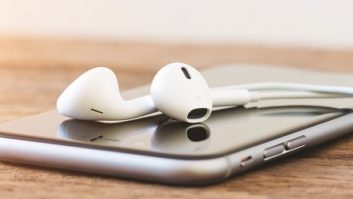
Broadcast radio is facing some significant challenges — and one of them involves young people.
That’s according to a recent report to the government of the United Kingdom. Though specific to the U.K. marketplace, the “Digital Radio and Audio Review” explores issues that are relevant to broadcasters everywhere.
The report was a joint government/industry project commissioned by the Department for Digital, Culture, Media & Sport, prompted by the question of whether analog radio services should be sunset.
The report has many positive things to say overall. It describes radio as “a great British success story” and said the medium has evolved to embrace digital opportunities to maintain universal appeal. It describes a “thriving” radio market and said new online formats from broadcasters and new entrants have grown rapidly, bringing “increased choice and new habits to the U.K.’s audio sector.”
It said radio remains a strong, trusted medium, and it goes on to explore issues such as consumption trends, the role of competing services, the state of DAB+, the impact of voice activation and so forth. It makes dozens of recommendations, some relevant only to the U.K., others that could be applied broadly. Its main conclusion was that the time is not right for a switch-off of analog radio services.
For anyone interested in large-scale radio trends, it is worth reading; here are links to the report and the government’s response).
But the report’s discussion about trends among young listeners is eye-catching.
Losing ground
The report notes an ongoing decline in young listeners as online music options proliferate.
“In the 10 years from 2010 to 2020, the weekly reach of live radio among 15–24s declined by 8% (or 7.1 percentage points) from 88.7% to 81.6%,” the review stated.
“During the same period, the average hours per 15–24 listener fell by 23% (from 16 hours 8 minutes in Q1 2010 to 12 hours 30 minutes in Q1 2020).”
“As a result, the total listening hours of 15–24-year-olds fell during the period by 34%,” it continued. As well, “Young audiences do not seem to sufficiently grow into radio later in life to compensate: 25–34s today are listening to slightly less live radio (16 hours 6 minutes in Q1 2020) than they were 10 years ago.”
Then there’s the emergence of smart speakers for in-home listening. The good news is that many people do listen to radio broadcasts on their smart speakers. The bad news: “Use of smart speakers to listen to the radio falls to 34% among 16–34s but rises to 67% among those aged 54 and over,” said the U.K. Review.
“In contrast, 67% of all smart speaker users listen to music via a streaming service on their device, rising to 77% of 16–34s but dropping to 55% of those aged 54 and over.”
Radio World asked industry observers about the implications of these declines in listening among the young.
“While cume/reach isn’t a problem, total time spent listening seems to be in decline for radio, especially at the younger end,” said James Cridland, radio “futurologist” and editor of the Podnews podcast newsletter.
“In the U.K., radio’s weekly time spent listening for people aged 15–24 on AM/FM, DAB and online has declined by almost 40% since Q2 2013. I see similar declines for TSL from young audiences in the U.S.”
There is no doubt that the emergence of online music services with tailored music experiences has cut into radio’s audience.
Meanwhile, “About a decade ago the radio audience began to split into two listener groups who wanted different things,” said Ben Downs, vice president and general manager of U.S. company Bryan Broadcasting, who is on the board of the National Association of Broadcasters.
While some listeners remain dedicated to listening to broadcast radio, he said, “There was the ‘jukebox group’ that had no interest in anything that stopped the music such as news, sports, traffic, weather — and unfortunately commercials. That’s the group that has drifted away from radio, because we generally can’t operate outside of our advertising-supported business model.”
However, some observers say the industry isn’t doing enough to build relationships with younger consumers and doing absolutely everything to attract them.
“I worry that programmers are doubling down on programming that attracts the older demographic, leaving nothing for younger listeners and accelerating the decline of the industry,” Cridland said.
In the long term, he said, “Radio aimed at people aged 55+ is hard to make money from, and harder to see new listeners dipping into.”
Online competition
What will it take to keep broadcast radio competitive, attractive and relevant to new generations of listeners?
Fred Jacobs has been pondering that. He is president of Jacobs Media, renowned for creating the classic rock format that is still popular today.
“Radio’s future can still go a variety of different ways, depending on how industry actors in these various countries choose to play their hands,” Jacobs told Radio World.
“They can lean into radio’s strengths, being live, local and free, and perhaps carve out a sustainable but different future. They can specialize in personality development, another core strength not being pursued by most streaming players. Or they can meet the audience where they are, weaning themselves off transmitters and towers as the dominant distribution outlet to provide content and services on myriad other channels. Many are doing this now, but in fits and starts.”
These are not the only options for broadcasters to compete with online services, said Jacobs.
“They can explore and experiment with alternative business models, not unlike what Bauer Media is doing in Europe with its subscription service. Offering versions of broadcast radio stations that are commercial-free and with ‘song skips’ could prove to be a viable option for already strong, well-established radio brands.
“They can also seek out strategic mergers, acquisitions, collaborations and partnerships to bolster their portfolios and capabilities, in much the same way that public radio station WBEZ recently purchased the Chicago Sun-Times. If that strategy is correct, the new Chicago Public Media entity could ‘own’ local news in Chicagoland.”
Broadcast radio’s unmatched ability to deliver “local and live” content was emphasized by NAB President/CEO Curtis LeGeyt in a recent edition of “Borrell’s Local Marketing Trends Podcast.”
“What is always going to differentiate radio is the trust of the local personality and the live programming,” LeGeyt said. “I think radio will continue to thrive in that regard, whether they are distributing that programming through an AM/FM traditional terrestrial signal, or whether that programming is being consumed through a stream through an adjacent podcast, whatever it may be.”
Radio critics have said for years that this “local and live” advantage is compromised when a station relies too much on automation and voice-tracking, not supporting listener music requests and on-air interactions, or using out-of-town announcers with no presence or connection in the community.
Another programming possibility: Radio stations could offer audiobooks and author interviews through HD Radio channels and web streams. According to www.wordrated.com, globally, audiobook revenue is projected to be worth $4.11 billion in 2021. So that’s one area where new listeners might be found.
“The other thing we have to do is quit annoying our listeners,” Downs said. “Our spot loads are now and have always been the greatest turn-off to free radio. Syndicated talk formats have places in their formats built for 20 to 22 minutes of commercials each hour — and don’t forget to count the top-of-hour newscasts. It’s hard to listen through that plus poorly researched playlists.
“As well, we need to find on-air talent that super-serves the community and keep them in our studio chairs. If we do all this, we may not get 100% of our audience back, but we can win back a lot.”
Unfortunately, said Cridland, “Radio’s reaction to declining linear audiences appears to be to cut costs on output, thus making radio even less likely to compete well with more interactive offerings by Spotify, Amazon and other services.
“Real human beings, producing relevant output to their audiences, appears to be the way forward,” he said. “‘Real and relevant’ can come from live and local, but it doesn’t have to. That said, it’s much harder to deliver ‘real and relevant’ using non-stop automated music or short presenter breaks voice-tracked six days ago in a different city.”
Another solution is offered by John Lund, president of the Lund Media Group consultancy.
“There needs to be a paradigm shift from perceiving radio as a device receiving content distributed from a transmitter and antenna,” he said. “Instead, radio should be perceived as content distributed by a transmitter and over the internet — apps for cellphones, website streams and smart speakers. The advantage terrestrial radio has is that it is a mass-marketing mechanism limited by licenses from the FCC. Satellite and internet content providers do not have this valuable marketing vehicle.”
Winning back the young
If one considers the data in the U.K. report, one might conclude that broadcast radio is doomed simply because it seems unable to attract younger listeners. Without them, radio’s fate presumably is tied to the life expectancy of the 55+ demographic.
But it doesn’t have to be this way, its supporters say. Radio has faced doom before, as when television supplanted radio as the mass-market venue for comedy, drama and other spoken-word programming. Radio survived by reinventing itself as a youth-focused music medium.
Young listeners can again save broadcast radio and will do so if the industry lets them.
Patrick Hannon is president of WorldDAB, which advocates for the DAB/DAB+ digital radio platform. “The key challenge for radio is to pursue a course that balances the need to encourage innovation, whilst simultaneously protecting the core strengths of broadcast radio,” he said.
He believes the multitude of additional channels provided by DAB+ digital radio makes it possible for radio to rebuild its connection to younger audiences.
“DAB+ can offer listeners more choice, such as new stations targeted at children, including ‘Fun Kids’ in the United Kingdom and ‘ABC Kids listen’ in Australia,” he said. “These stations help build radio listening habits from an early age, as well as providing educational and entertaining content.
On the other hand, said James Cridland, “Podcasting is showing that younger audiences are keen to seek out the kind of programming they want on their terms. It’s telling that the big U.S. broadcasters are heavily investing in the podcasting industry, though also telling that podcasting accounts for just 9% of iHeart’s total revenue or 6% of Cumulus Media’s revenue.”
Downs said, “While I wish young people were more interested in their community, they will listen to our signals if we give them something they can’t find anywhere else. And if we’re good enough we’ll be able to share them with the all-music services. In our case, our collegiate sports radio programs are a unique product that motivates young people to listen.”
Said Fred Jacobs: “The teen issue is especially challenging, largely because most broadcasters have mistakenly and myopically chosen not to compete in that arena. But Gen Z is not actively ‘anti-radio.’ There’s simply never been anything on the radio of interest or relevance to them.”
But that does not mean a content stream or platform couldn’t be devised that would appeal to them. Jacobs noted that TikTok has disrupted juggernauts Facebook, Instagram and others but it didn’t even exist until 2016.
What’s ahead?
Can radio survive this second extinction-level event, the onslaught of online music services? Our conversations with experts keep coming back to the notion that stations must reinvest in the “local and live” model to which so many publicly traded broadcast groups give lip service.
“Radio — in a more complex media future — cannot and will not be what it was,” concluded Fred Jacobs.
“But in every phase of its evolution, it has morphed to meet the moment. The challenge of today is more arduous and financially precarious, but the medium has the ability to adapt and become a different version of itself. The question is whether its owners/operators have the wherewithal, the stamina and the innovativeness to make it happen.”
And what did “Digital Radio and Audio Review” conclude about the youth issue?
“The U.K. radio industry is actively trying to address the shifting needs of these young listeners,” it told the government.
“Commercial radio has launched a number of new digital-only services such as KISS Garage and developed online audio players such as Global Player, while the BBC has further evolved BBC Sounds and launched, for example, a new stream of content to help young audiences manage stress and wellbeing.
“Existing initiatives show some signs of success,” it stated, “but the challenge will intensify as online audio audiences grow, leading competing global providers to further increase their investment in music streaming and podcast services.”
More broadly, the report acknowledges that radio is facing “significant” challenges.
“While the BBC and commercial broadcasters have invested heavily in developing and improving DAB transmission infrastructure, and broadcast platforms continue to dominate both in-home and in-car audio entertainment, the options for what to listen to and the ways of listening to radio services continues to increase. Audiences are changing, distribution is changing, and connected audio and global streaming platforms such as YouTube, Amazon Music and Spotify are competing for the radio audience.
“The future is still a bright one — especially as opportunities open up for the audio production sector — but significantly less certain, and much will depend on industry continuing to collaborate to sustain a thriving audio ecosystem of U.K.-produced content.”






